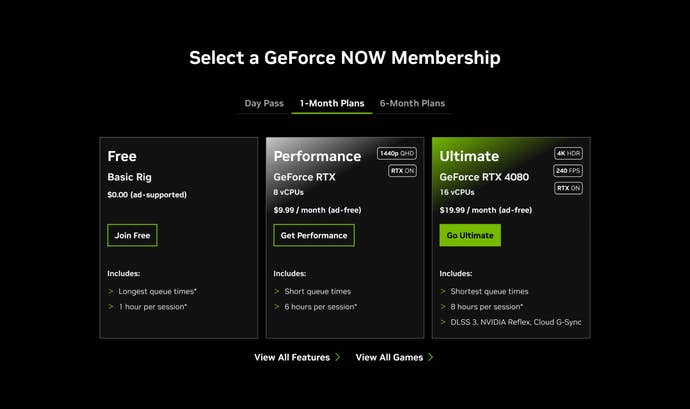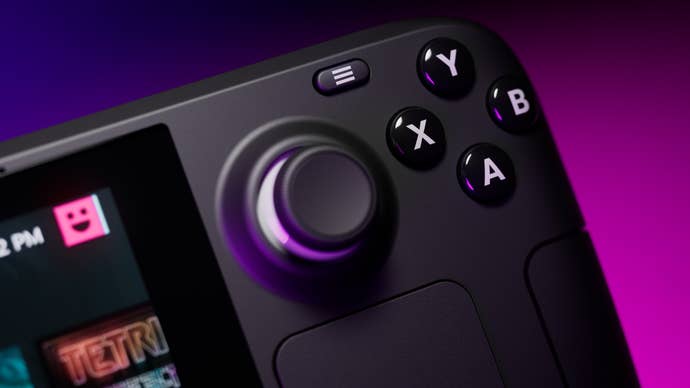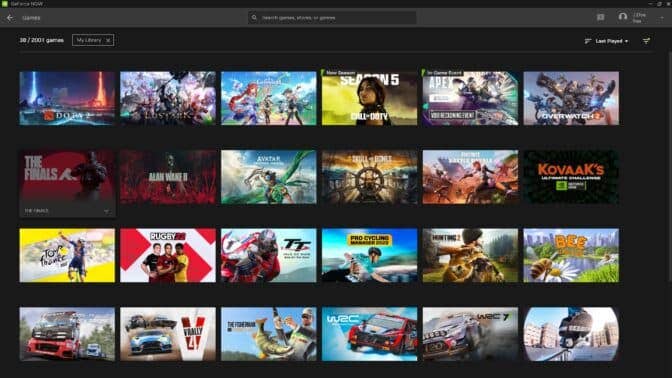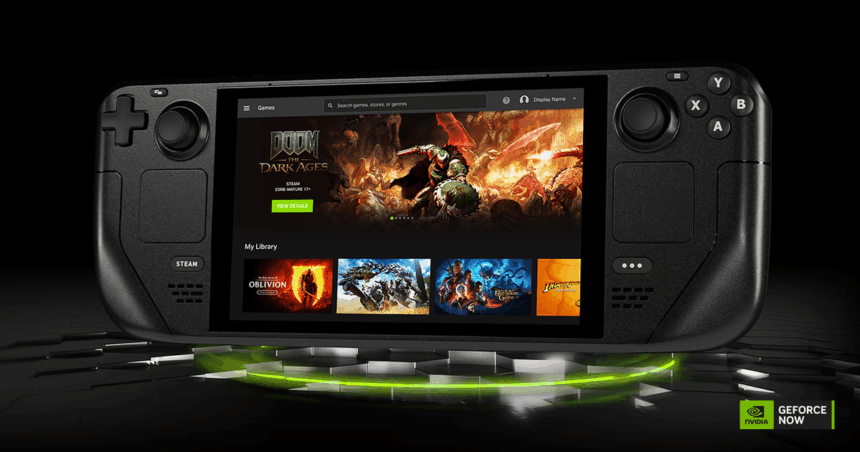Every now and then, something comes along in my video gaming life that I feel the need to evangelise. Even if I’m super late to the party – as I am here. So picture me, knocking on your door. Or ringing the bell. Whatever. Ding-dong. Hello! Can I talk to you about GeForce Now on Steam Deck? It might just change your life.
Alright, that might be a bit much. That’s something of an oversell. I tell you what, though – it’s bloody good. I liked my Steam Deck well enough as it was, even though it primarily served as an extremely ergonomic Balatro-on-the-go machine – absolute overkill for a game I have on my phone anyway. It has nevertheless served me well on transatlantic flights. Right as the Switch 2 started to draw away my attention (on my last eight-hour haul, I played a hell of a lot of Mario Kart World and left the Deck at home), the device has been recontextualized. The trigger? Nvidia’s GeForce Now service.
To see this content please enable targeting cookies.
If you’re not familiar with GeForce Now, it’s one of the few remaining ‘serious’ game streaming services left. Where Stadia arrived with a huge splash only to end up in Google’s metaphorical glue factory after just a few years of life, Nvidia has been much more quietly and diligently plugging away at its service for over a decade now – and the results are rather remarkable. This is true on pretty much any platform it’s available on: this is the best game streaming service out there.
One of the smarter plays is that Nvidia isn’t as interested in being an all-in-one service. This provides GeForce Now focus. It’s not trying to sell you games, or become your primary place to play games. It wants to be the service you use when you need to stream games. That’s it.
Subscriptions for GeForce Now run £10 or £20 per month depending on what specs and restrictions you’re willing to accept, with 15% discounts available for paying bi-yearly rather than monthly. The cheapest variant of the best package will run you £200 for a year, giving you 4K and 240 frames-per-second game streaming with ray traced visuals in compatible games.
If you are just away from your rig for a few days and desperate to game, you can pick up day passes to the service for as little as £4. I could totally see someone hideously hooked on a service game paying this to do their dailies from a hotel room or what have you. There’s also a free tier, where you’re limited to one-hour sessions and have to watch an ad before playing – but really, this service is about subscriptions.

Once you’re in, you can stream anything that’s available in the GeForce Now library so long as you have the right to play it. Your subscription is basically only getting you access to Nvidia’s hardware stack to run and stream in the games – so it’s up to you to provide the digital licenses. GeForce Now hooks into your libraries from services like Steam, the Windows/Xbox PC Store (including Game Pass), GOG, Epic Games Store, and so on. If you own a game (either outright or as part of a subscription) and it’s one of GeForce Now’s 2000-plus compatible games, you can run it via their servers without installing it.
When you connect to play a game, somewhere off in a server center a device that has the power level of a pretty highly-specced gaming PC boots and begins to share its screen with you. You share your inputs back, and there you have it: modern games, ray traced, but with none of the local hardware heft required.
You can do all of this from a PC with a native app or indeed via a compatible browser – but the big recent addition on Nvidia’s part, a few months ago, is an app for Steam Deck.
This isn’t exactly native in the sense that you can’t just install it straight from the Steam Store. You have to deal with an installation process that involves putting the Deck into its desktop mode in order to download and install the app. But once you’ve got it, it’s fully optimized for Deck and can be launched from the usual interface – and it’s honestly pretty brilliantly done. Whereas getting GeForce Now running on Deck was a recurring faff before, with this app’s release it’s now a one-time pain. And that pain certainly feels worthwhile.

There’s a few advantages that have allowed the GeForce Now x Steam Deck combination to sink its claws into me so effectively. First: why did I primarily gravitate towards games like Balatro and Into the Breach on Deck any time I flew? Because I couldn’t stand squinting at fuzzy visuals in ‘big’ games that sapped the battery in an hour and a half.
Second: why did my Deck begin to have limited utility at home? Well, any time I tried to play something remotely intense in the living room, in the bedroom if I couldn’t sleep, or anywhere else my wife was present, she’d complain about the districting (and to be fair to her, not insignificant) fan noise any more intense, heat-generating game would cause.
Typically, this meant my Steam Deck became the realm of simple, addictive, low-impact games. Like I said: Balatro machine. Many of my 400+ Steam Hours chasing achievements were on Deck. That’s fine and dandy, and I wouldn’t want to lose that – but streaming is super low-impact – and better-looking. It changes things.
Take Clair Obscur: Expedition 33, for instance. That’s a game that is Deck Verified and runs pretty decently on the device already. But it is also undoubtedly compromised. Fuzzier, lower resolution and frame rates… It’s a hobbled version of a great game, but a worthy compromise to have it on the go. With GeForce Now you can play it better, though. It’ll run at a higher resolution, and with visuals equivalent to the game’s ‘Epic’ preset.
Let me tell you something: any potential streaming artifacting that we might hand-wring over is nothing in comparison to the dip in quality you get from playing natively on Deck. The Deck’s battery life will last upwards of six hours doing this, too. So it seems like a no-brainer to stream, right?
With that said, streaming doesn’t exist as a replacement. As previously noted, it seems like that isn’t Nvidia’s goal. So this streamed version of Expedition 33 exists in tandem with the other, more traditional methods. Playing it on Steam means all save games are synced. I can play on my mega-spec PC with everything maxed out, then stream to Deck to play in a different room, and if I did want to play it on-the-go or somewhere without good quality wifi, I could continue natively in a compromised visual state.
Lag, of course, is a thing – but all I can say is that I’ve not been missing too many of Expedition 33’s plentiful parries. It’s here where Nvidia’s commitment can be seen best, I suppose – manifested in aggressive expansion of data centres right around the globe. A huge chunk of the population already has extremely nearby GFN servers to connect to, strengthening connections and reducing latency in the process.
There are caveats and drawbacks, naturally. GeForce Now is a growing service, and I have seen it change, shift, and improve a lot over the last decade. It’ll continue to do so, and I hope in time it feels a little less hitchy, bandwidth requirements ease, and it can be better integrated with Deck in general (you can’t just press the power button to quit in a hurry, for instance – you really do need to ‘close out’ your GeForce Now streaming session to quit).
There’s also the cost. £20 a month is quite a lot for something that is practically by Nvidia’s own tacit admission a secondary way to play your games – and though there are cheaper options, the ‘Ultimate’ subscription tier is really the only one I’d heartily recommend. Part of the reason for that is quality – the other side is capacity, which is another drawback – at peak times on lower subscriptions it is possible to end up in a short ‘queue’ waiting for an available rig. Ultimate subscribers get priority.

Finally, there’s the games: with over 2000 titles available Nvidia is clearly killing it in compatibility terms – but for many of us that’ll still be a fraction of our libraries. I own some 1200 games on Steam (I know. Look. I’ve been doing this job for a long time), and around 350 are available on GFN. Many of the missing titles are ancient, admittedly – but still. A key challenge for Nvidia is going to be getting more games into the service, which requires explaining the services and signing deals with publishers.
There are myriad bangers present, mind. Alongside Expedition 33 you can happily experience stuff like Hitman, Cyberpunk, Tony Hawk, Peak, Rematch, Flight Simulator and so on… But you can also note plenty of stuff that isn’t in it: Elden Ring, GTA5, Persona. And sometimes it feels outright random, like how Final Fantasy 16 is on GFN but no other entry – not even the later-released FF7 Rebirth or perfect-for-streaming & controller-friendly MMO FF14 – is.
Based on the last ten years I’m convinced that this sort of uptake will come in time, though. I expect if the audience continues to grow, we should see capacity grow as well. The advent of truly portable PC gaming has changed the market in many ways – and one chief among them might very well be to make that promise of streaming more viable again, at least for using that portability in semi-tethered locations – around the house, away from home but with good wifi, and so on. Certainly, it’s changed the way I play – and for the better.





